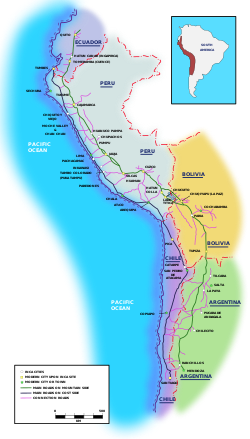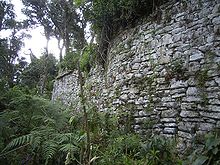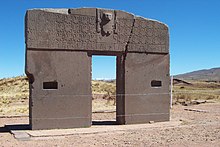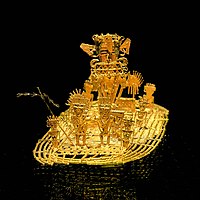Andean civilizations
[3] Despite the severe environmental challenges of high mountains and hyper-arid desert, the Andean civilizations domesticated a wide variety of crops, some of which, such as potatoes, peppers, peanuts, manioc, chocolate, and coca, became of worldwide importance.The Andean civilizations were noteworthy for monumental architecture, an extensive road system, textile weaving, and many unique characteristics of the societies they created.After the first humans — who were then arranged into hunter-gatherer tribal groups — arrived in South America via the Isthmus of Panama, they spread out across the continent, with the earliest evidence for settlement in the Andean region dating to circa 15,000 BCE, in what archaeologists call the Lithic Period.Scholars differ on whether the knotted cords of the quipu were able only to record numerical data or could also be used for narrative communication, a true system of writing.People on land traveled only by foot and the transport of goods was accomplished by humans or llama, pack animals which could carry loads of up to one-fourth of their weight, a maximum of 45 kilograms (99 lb).Agriculture was possible only with irrigation in valleys crossed by rivers coming from the high Andes, plus in a few fog oases called lomas.In the Andes, agriculture was limited by thin soils, cold climate, low or seasonal precipitation, and a scarcity of flat land.[16] Some scholars believe that the earliest civilizations on the Peruvian coast initially relied more upon maritime resources than agriculture during the formative period of their societies.In the mountains, the elevation, cold climate and steep terrain required a range of technological solutions such as terraces (andén), exploitation of microclimates, and selective breeding.At a macro level, societies and states did the same with the vertical archipelago, establishing colonies at different elevations and locations to increase the possibilities of agricultural success.The alternative name, Caral-Supe, is derived from the Sacred City of Caral[26] in the Supe Valley, a large and well-studied Norte Chico site.Complex society in Norte Chico arose a millennium after Sumer in Mesopotamia, was contemporaneous with the Egyptian pyramids, and predated the Mesoamerican Olmec by nearly two millennia.Rather, they were likely a group of autonomous polities that shared a common elite culture, as seen in the rich iconography and monumental architecture that survive today.The Wari (Spanish: Huari) were a Middle Horizon civilization that flourished in the south-central Andes and coastal area of Peru, from about CE 500 to 1000.Also well-known are the Wari ruins of Pikillaqta ("Flea Town"), a short distance south-east of Cuzco en route to Lake Titicaca.Tiwanaku is recognized by Andean scholars as one of the most important precursors to the Inca Empire, flourishing as the ritual and administrative capital of a major state power for approximately five hundred years.The site was first recorded in written history by Spanish conquistador and self-acclaimed "first chronicler of the Indies" Pedro Cieza de León.From 1438 to 1533 CE, the Incas used a variety of methods, from conquest to peaceful assimilation, to incorporate a large portion of western South America, centered on the Andean mountain ranges, including Peru, southwest Ecuador, western and south central Bolivia, northwest Argentina, northern Chile, and a small part of southwest Colombia into a state comparable to the historical empires of the Old World.


















Human historyPrehistoryStone AgePleistocene epochHoloceneTimelinesNeolithicContemporary10,000 BCEAge of the human raceRecorded historyCommon EraEarliest recordsProtohistoryProto-writingAncientCopper AgeBronze AgeIron AgeAxial AgeClassical antiquityLate antiquityNorth AmericaEast AsiaSouth AsiaWest AsiaEuropePostclassicalTimelineAmericasOceaniaRenaissanceModernEarly modernAge of DiscoveryModernityPostmodernityFuturologyPolitical historyFutureHistory of PeruPre-Columbian PeruInca EmpireSpanish conquestViceroyaltyWar of IndependenceFoundational PeriodProtectorate of PeruSupreme Governing JuntaConfederationRestorationMilitary AnarchyGuano EraChincha Islands WarWar of the PacificPeruvian ResistanceNational ReconstructionAristocratic RepublicNew MotherlandEcuadorian–Peruvian WarOdría DictatorshipModerate civil reformRevolutionary GovernmentReturn to democracy and terrorismInternal conflictEconomic crisisPeruvian political crisisHistory of the Inca EmpireDemographic historyEconomic historyConstitutional historyPeruvian warsYears in PeruCoups d'étatcomplex societiesindigenous peopleColombiaEcuadorArgentinacivilizationsPacific OceanCaral or Norte Chico civilization"pristine" civilizationpotatoespepperspeanutsmaniocchocolateroad systemSpanishTimoto CuicaHistory of Andean South AmericaAsperohunter-gathererIsthmus of PanamaAndean preceramicCaral-Supe civilizationKotosh Religious TraditionChavín cultureParacas cultureNazca cultureTiwanaku EmpiresChimorMachu PicchuTahuantinsuyuKingdom of CuzcoSpanish Empireone of six in the world deemed by scholars to be "pristine"indigenous people of the AndesOld WorldWari EmpireCaral/Norte Chicoplowingridingaxe-moniesSpondylusandenessquashLas Vegas cultureMexicoquinoatomatoeschile pepperscottontobaccopineapples